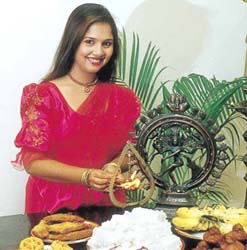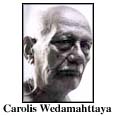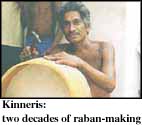
9th April 2000
News/Comment|
Editorial/Opinion| Business| Sports|
Sports Plus| Mirror Magazine


- A 'time' to enjoy
- In the scheme of things...
- They love the beat
- Kala Corner - by Dee Cee
- Mangoes in Colombo! - Taste of Sinhala -14
- Majestic heights
- The movie and the still-life
- A brush with flames
- Ajanta's fame and Ellora's eminence
- Save the Sinhala nation from terrorists - Point of view
- The sport of kings and commoners
- Ascot Time
- Hard trek to exciting panoramic view - Book review
- Farewell to the TriStar
- Rhythm in our lives - West meets East
- TB - the good and the bad
- Guerrilla turned roving ambassador
- Royal ride of the '50s
- Looking back at the grandeur that was
- South African rights: model for Sri Lanka - Liberal Party proposals for a new Constitution
- News 100 years ago
- Human aspects of war reporting
- Work towards people oriented security and democracy
- Godfathers from a Colombo school
- Letters to the editor








A 'time' to enjoy
Chamintha Thilakarathna reports on the origins of nekath
From time immemorial man has been governed by the sun, moon and stars. Take our New Year celebrations. What makes them tick? Apart from the frenzy of shopping for new clothes and making delicious kavum and kokis, the real excitement is generated by lighting the hearth, partaking of the first meal, anointing our heads and bathing, doing a transaction or setting off to work on the dot - the nekath time.What do we mean by nekatha or auspicious time? How and who decides? How auspicious times originated no one can verify. But they are there, millennium or no millennium, and despite technological advancement, most of us in Sri Lanka live by them.
Ever since man became aware of the stars, astrology and auspicious times have existed. Some say that 18 astrologers existed before Parasara who introduced the Surya Siddantha. This, according to astrologers, is the base of all astrological calculations. Parasara, they say, used to get on a platform and gaze at the stars, then calculate the movement of the sun to find out the dawn of the year.
 Carolis
Vedamahattaya, popular astrologer said, "When deciding on auspicious times
the sun's movement plays a great role." Although we know that it is the
sun's arrival from Pisces to Aries, which is called the dawn of the new
year, when it comes to selecting an auspicious time this information is
insufficient.
Carolis
Vedamahattaya, popular astrologer said, "When deciding on auspicious times
the sun's movement plays a great role." Although we know that it is the
sun's arrival from Pisces to Aries, which is called the dawn of the new
year, when it comes to selecting an auspicious time this information is
insufficient.
Each day is divided into five elements. "Dinaya, Thithi, Yoga, Nekatha and Karana. (They cannot be given strict definitions as they have only marginal differences.) With these, the Rikthas are also taken into consideration, when deciding on an auspicious time," he said.
The Vedamahattaya explained that the Rikthas stand for inauspicious, harmful or dangerous times. There are 10 called the Dasa Maha Dosa (10 main dangers). The auspicious time is usually when all danger factors are not present.
The Sinhala New Year is based on a sun-centred calendar, indicated as Duruthu, Navam, Medin, Bak, etc. It starts with April and comes back to April, completing the full cycle. Another factor which should be taken into account is that an hour in the astrological calendar does not always contain 60 minutes.
"If any of the Rikthas are present then it could be dangerous. Most of the Rikthas and Yogas refer to ill concepts. Some of them are mara yoga, visha yoga, bumi yoga and so on. Of the 28 nekaths any of the remaining 18, sans the bad 10, could be used for auspicious activity.
The best time is also decided taking into consideration the five factors of the day. "For example, if the day has a Riktha we would put it aside, if the date is a four or a nine then we put that aside too, because astrologically such days are said to spell danger," he said. However, the date does not refer to the date on the Roman calendar, but is an astrologically calculated one.
 Explaining
the concept and manner in which auspicious times work, renowned astrologer
Daniel Gamaariya said that scientifically the sun's movement takes place
on March 22, which is also known as the hottest day on earth.
Explaining
the concept and manner in which auspicious times work, renowned astrologer
Daniel Gamaariya said that scientifically the sun's movement takes place
on March 22, which is also known as the hottest day on earth.
"But, astrologically we consider the time at which the sun's rays first fall on Aries as the dawning of the New Year," he said. From this moment a 12-hour period is set aside for the events of the New Year. The first six hours are usually considered the nonekatha period, sans auspicious times.
But what about the best time to eat, bathe, light the hearth etc? "In each day, a timeframe is dedicated to each astrological planet. The planets also have their most favoured activity. So, we find the time-frame dedicated to the moon within the day and select the best time according to the elements of a day (as mentioned above) to decide when to light the hearth, for example. This is because the moon is astrologically believed to be in favour of work," Mr. Gamaariya said.
Similarly, planets known as Guru and Chandra are said to favour dining. The time is selected within that frame of the day dedicated to these planets and this year, it falls within Guru.
Citing other examples, he said that Buda is best suited to start education, Sikuru for travelling, Guru and Brahaspathi for marriage and so on. "However, we always avoid time-frames dedicated to Senasura, Kuja and Rahu as they are believed to be danger planets."
"Nowadays, some people do not abide by auspicious time, due to practical problems, when starting professional activity. But this does not mean that everything will fall flat. What we say is that if you work by astrological times, things could improve," Mr. Gamaariya explained.
What awaits us in the New Year? The astrologers would only say that
Virgo will be at an advantage because the new year falls on Virgo.
In the scheme of things...
"Conquer time and you can conquer the self," the sage said."Why conquer the self?" the disciple asked.
"Conquering the self, or rather losing it. This is the highest form of attainment in anybody's spiritual life. And perhaps space," the guru replied.
I opened my eyes and blinked. In front of me, hanging on the wall… was a clock, solemnly ticking away the unused seconds of my life. It is time to wake up and get ready to go to the kovil. The New Year will be born pretty soon. Can't afford to miss it. The time. I rush to the bathroom.
So we are caught in the web of Time. Everything is done according to a Time.
Time, is everything. Or it seems so.
From ancient times the Hindus have given an important place to the concept of time. Yet they have known that timelessness is the ultimate. That God is beyond it.
"Somanaiyum Kalanaiyum Vendra Adi," says Appar Swamigal in his hymn.
But despite all this, we don't care much about time in this part of the world. Funny, isn't it?
So coming back to my bath, I have it and go to the shrine room. Get dressed in the stipulated colour in the Panchangam. The calendar calculator, which helps calculate auspicious times is called Panchangam for it uses five factors. The Panchangam decrees the colour basing on the time of the birth of the New Year.
So the colour for the year comes under Time's realm as does everything else — cooking, bathing, eating, starting work, business, Kai Vishesham, etc. You name it. There is a time to do it.
Then each year has a name. There are 60 years in a cycle. Twelve months in a year and seven days a week. And then there are 27 stars. Twelve rashies. And much, much more.
Every New Year has a unique astrological chart of its own. Nothing escapes. Panchangam laid down the time for everything.
Schools have timetables, the office working hours, flights are either on time or delayed. You have to be on time to catch a flight. You get caned if you're late to school or your pay is cut if you don't report to office. Petty schemes.
Panchangam is a cosmic scheme. Perhaps, it helps understand the helplessness of man in the scheme of things in the cosmos, to understand the greatness of timelessness.
Too complicated? Forget it.
It is time to enjoy the Varushappirappu.
Happy New Year to you.
-Maha
For Kinneris and his relatives drums are their line of business
They love the beat
By Nilika de Silva
 As
the Sinhala-Hindu New Year approaches and traditions are rekindled, people
turn towards familiar, familial habits.
As
the Sinhala-Hindu New Year approaches and traditions are rekindled, people
turn towards familiar, familial habits.
The koha adding its vibrant message to the air, Eramudu blooming in profusion and the scorching sun shining brightly are all reminders that it's that time of year.
Preparations are on with homes being "spring-cleaned" and sweetmeats being fried for the New Year.
In a house off the beaten track, in Heyyanthuduwa, near Biyagama P. Kinneris Perera and his relatives are gathered in their 'workshop', which is the verandah, turning out drums of all shapes and sizes. But the one in demand these days is the rabana.
As I watched them at work, in my mind's eye I saw pretty village lasses in their colourful cloths and jackets sitting around those big, big rabanas playing pada in competition.
Kinneris has been in this line of business for the past 20 years, handed down from father to son, with the whole family sharing the skills.
His niece in her home a few hundred yards away, finds time to add the finishing touches to the small drums, with deft strokes of the paintbrush. These will be sold at fairs and marketplaces all over the country.
For Kinneris and his family, fulfilment comes when during the Avurudhu they hear the rhythmic beat of the rabanas, which they have turned out so laboriously, yet lovingly.
![]()
Front Page| News/Comment| Editorial/Opinion| Plus| Business| Sports| Sports Plus| Mirror Magazine
Please send your comments and suggestions on this web site to

